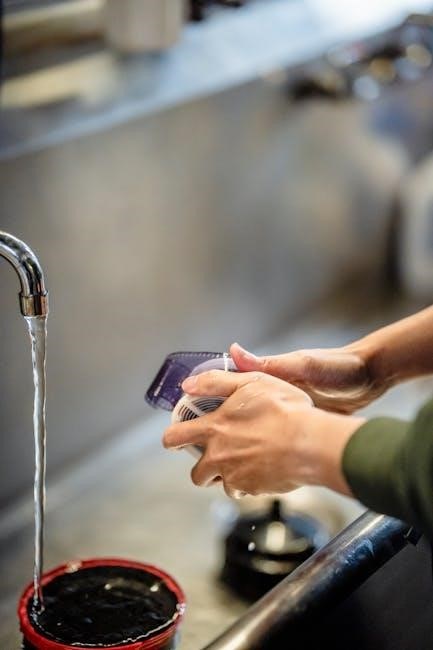This manual provides essential guidance for installing‚ operating‚ and maintaining your GE water softener‚ ensuring optimal performance‚ safety‚ and troubleshooting for a superior water quality experience.
1.1 Overview of GE Water Softeners
GE water softeners are designed to remove hardness minerals‚ offering softened water for household use. They feature advanced technology like the Custom Select™ blending valve‚ which allows users to adjust water softness levels. These systems are efficient‚ reducing salt‚ water‚ and energy usage during regeneration. GE softeners also include a self-cleaning sediment filter to protect plumbing and appliances. They support both sodium chloride and potassium chloride for regeneration‚ catering to different user preferences and dietary needs. These units are built for reliability and long-term performance‚ ensuring improved water quality throughout your home.
1.2 Importance of the Manual for Installation and Maintenance
The manual is crucial for proper installation and maintenance of your GE water softener. It provides step-by-step installation guidance‚ ensuring compliance with safety standards and optimal system performance. Regular maintenance tasks‚ such as salt management and filter cleaning‚ are detailed to prevent issues like salt bridges and drain hose dripping. The manual also offers troubleshooting tips for common problems‚ like water not softening or high brine tank levels. By following the manual‚ users can extend the system’s lifespan and maintain efficient operation‚ ensuring continued access to softened water and protecting their home’s plumbing.

Understanding Your GE Water Softener
Explore the key features and benefits of your GE water softener‚ including advanced settings‚ energy efficiency‚ and customizable options for optimal water quality and system performance.
2.1 Key Features of GE Water Softeners
GE water softeners feature advanced technologies like the Custom Select™ Blending Valve‚ offering precise control over water softness. They also include a self-cleaning sediment filter‚ reducing maintenance and protecting plumbing. High-efficiency designs minimize salt and water usage during regeneration‚ while the intuitive control panel simplifies system management. Additionally‚ these softeners are designed for quiet operation and durability‚ ensuring reliable performance and long-term savings on energy and detergent costs.
2.2 Benefits of Using a GE Water Softener
GE water softeners offer numerous benefits‚ including customized water softness‚ significant savings on salt‚ water‚ and energy‚ and reduced detergent usage. They protect plumbing and appliances from scale buildup‚ extending their lifespan. The self-cleaning sediment filter minimizes maintenance‚ while advanced features ensure efficient operation. These systems also reduce environmental impact by optimizing resource use‚ making them a practical and eco-friendly choice for improving water quality and household efficiency.
2.3 Custom Select TM Blending Valve Explained
The Custom Select TM Blending Valve allows users to adjust water softness levels according to their preferences. This innovative feature enables precise control over water hardness‚ ensuring optimal comfort while reducing salt and water usage. By customizing the blend of softened and unsoftened water‚ it offers flexibility for varying household needs. The valve also contributes to the system’s efficiency‚ helping to minimize waste and optimize performance. This feature is a key advantage of GE water softeners‚ providing users with tailored solutions for their water treatment requirements.

Installation Instructions
Follow step-by-step guides for proper installation‚ including connecting water supply lines‚ electrical setups‚ drain hose placement‚ and bypass valve configuration to ensure your system operates efficiently and safely.
3.1 Pre-Installation Requirements
Before installing your GE water softener‚ ensure you have the necessary tools and information. Measure water hardness levels‚ choose an ideal location near a drain‚ and confirm electrical access. Check the model-specific requirements for inlet/outlet sizes and ensure the area is clear for easy access. Review the manual for compatibility with your plumbing setup and gather all provided components. Consulting the manual beforehand ensures a smooth and efficient installation process for your water softening system.
3.2 Connecting the Water Supply Lines
Shut off the main water supply before connecting the lines. Use the provided adapters to secure the inlet and outlet hoses to the softener. Ensure the inlet connects to the cold water line and the outlet to the water distribution line. Position the bypass valve correctly to allow water flow control. Tighten all connections firmly to prevent leaks. Double-check the alignment and seating of the adapters for a secure fit‚ ensuring proper water flow direction as specified in the manual.
3.3 Electrical Connections and Power Requirements
Connect the water softener to a 120V‚ 60Hz power source. Use a grounded‚ 3-prong outlet protected by a GFCI. Avoid extension cords or adapters. The system requires minimal power during operation‚ with a built-in transformer for low-voltage controls; Ensure the power cord is kept away from water to prevent damage. Plug directly into the outlet for safe and reliable operation. Refer to the manual for specific electrical requirements and safety precautions to ensure proper installation and functionality.
3.4 Drain Hose Installation
Connect the 3/8″ drain hose to the water softener valve drain fitting using the provided adapter. Secure the hose with a clamp and route it to a nearby drain. Ensure the hose is free from kinks or tangles. Position the drain hose so it flows downward to prevent backflow. The drain must be at least 6 inches above the floor to meet safety standards. Avoid sharp bends in the hose to maintain proper water flow. Follow the manual for specific installation guidelines to ensure correct setup and functionality.
3.5 Bypass Valve Setup
Install the bypass valve to allow manual switching between hard and soft water. Mount it near the softener inlet and outlet. Connect the valve to the water supply lines‚ ensuring proper alignment with the system. Use the supplied adapters if necessary. Secure the valve tightly to prevent leaks. Test the valve by switching between positions to confirm proper function. Refer to the manual for specific installation diagrams and instructions to ensure correct setup and safe operation.

Maintenance and Care
Regularly check salt levels‚ clean the sediment filter‚ and ensure proper system function. Schedule periodic maintenance to maintain efficiency and extend the lifespan of your water softener.
4.1 Regular Maintenance Tasks
Regular maintenance ensures your GE water softener operates efficiently. Check salt levels monthly and refill as needed to prevent salt bridges. Clean the sediment filter every 1-2 months to maintain water flow and protect plumbing. Inspect the drain hose for kinks or blockages and ensure proper drainage. Monitor the system’s performance and adjust settings if water hardness changes. Schedule professional inspections annually to verify optimal function and address potential issues early.
4.2 Salt Management and Refilling
Proper salt management is crucial for optimal performance. Check salt levels monthly and refill when necessary to avoid salt bridges. Use high-quality salt or potassium chloride as an alternative for sodium-restricted diets. Ensure the brine tank is filled to the recommended level to maintain regeneration efficiency. Avoid overfilling‚ as this can lead to high water levels. Refill salt before it runs out to ensure continuous softening. Regularly inspect for salt bridges and clean if needed to prevent system malfunctions.
4.3 Cleaning the Sediment Filter
Regular cleaning of the sediment filter is essential to maintain water quality and system efficiency. GE water softeners feature a self-cleaning design‚ but manual cleaning is recommended every 1-2 months. Turn off the water supply‚ then disconnect and rinse the filter under running water to remove debris. Reconnect the filter and ensure proper alignment to prevent leaks. Cleaning the sediment filter prevents clogs and ensures optimal water flow‚ protecting your home’s plumbing and maintaining softened water quality consistently.
4.4 Sanitizing the System
Sanitizing your GE water softener system is crucial for maintaining water quality and hygiene. Start by disconnecting the system from the power supply and draining the water. Mix a solution of food-grade hydrogen peroxide or white vinegar with water‚ then circulate it through the system. Allow it to sit for 30 minutes before rinsing thoroughly with clean water. Regular sanitization prevents bacterial growth‚ ensures fresh water taste‚ and prolongs the system’s efficiency and lifespan.

Troubleshooting Common Issues
This section helps identify and resolve common problems like water not softening‚ salt bridges‚ or high brine tank levels‚ ensuring your system operates efficiently and effectively always.
5.1 Water Not Softening Properly
If your water isn’t softening correctly‚ check salt levels and ensure the softener is regenerating. Low salt or a salt bridge can prevent proper operation. Verify the grain capacity matches your water hardness. Ensure the bypass valve is in the correct position. If issues persist‚ review the manual for troubleshooting steps or contact GE support for assistance. Regular maintenance can help avoid such problems and ensure softened water quality consistently.
5.2 Salt Bridge Formation
A salt bridge is a solid layer of salt that forms in the brine tank‚ preventing water from dissolving the salt during regeneration. This occurs due to high humidity or using the wrong type of salt. To fix this‚ manually break the bridge with a stick or scoop‚ ensuring the salt is evenly distributed. Afterward‚ check and refill salt levels as needed. Regularly inspecting the brine tank and using high-quality salt can help prevent future salt bridge formation and maintain optimal softener performance.
5.3 High Water Levels in the Brine Tank
High water levels in the brine tank can occur due to a malfunctioning float valve‚ clogged drain‚ or improper venting. Check the float assembly for obstructions and ensure the drain line is clear. If the issue persists‚ inspect the brine tank’s overflow elbow and vent tubing for blockages. Adjusting the float or replacing faulty components can resolve the problem. Regular maintenance‚ such as cleaning the vent and ensuring proper installation‚ helps prevent excessive water accumulation and maintains efficient brine tank operation.
5.4 Drain Hose Dripping
Drain hose dripping can occur due to loose connections‚ improper installation‚ or blockages. Check the drain hose for kinks or obstructions and ensure it’s securely attached to the softener. Verify the drain line slope is correct for proper water flow. If dripping persists‚ inspect the check valve or float assembly for damage. Cleaning or replacing faulty components can resolve the issue. Regular inspection and maintenance of the drain system help prevent leaks and ensure smooth operation of your GE water softener.

Downloading and Using the Manual
Download the GE water softener manual from the official GE Appliances website by entering your model number. This guide provides detailed installation‚ maintenance‚ and troubleshooting instructions for optimal use of your water softener.
6.1 How to Download the GE Water Softener Manual
To download the GE water softener manual‚ visit the official GE Appliances website. Navigate to the support section‚ enter your model number in the search bar‚ and select the appropriate manual. Choose the desired language and format‚ then click “Download.” Ensure you have a PDF viewer installed to access the document‚ which covers installation‚ maintenance‚ and troubleshooting. This step-by-step guide helps you efficiently operate and care for your water softener system.
6.2 Navigating the Manual for Specific Information
Once downloaded‚ navigate the GE water softener manual by using the table of contents or search function to locate specific topics. Sections are organized by categories like installation‚ maintenance‚ and troubleshooting. Use keywords or model numbers to quickly find relevant information. The manual also includes diagrams and step-by-step guides for clarity. Refer to the index for terms or components‚ ensuring efficient access to the details you need for optimal system operation and care.

Technical Specifications
GE water softeners feature grain capacities up to 40‚000‚ handling various water hardness levels. They use up to 34% less salt and 35% less water‚ ensuring high efficiency and performance.
7.1 Grain Capacity and Water Hardness
Grain capacity determines the water softener’s ability to remove hardness minerals. GE models range from 30‚000 to 40‚000 grains‚ suitable for various household sizes and water hardness levels. Higher grain capacity systems are ideal for larger families or extremely hard water conditions‚ ensuring continuous soft water supply. The softener measures water hardness in grains per gallon (GPG) and adjusts accordingly. This feature ensures efficient operation‚ optimizing salt and water usage during regeneration cycles for improved performance and sustainability.
7.2 Salt and Water Usage Efficiency
GE water softeners are designed to optimize salt and water consumption. They use up to 34% less salt and 35% less water during regeneration compared to traditional systems. The Custom Select TM blending valve allows precise control over water softness‚ reducing waste. Advanced regeneration cycles ensure efficient resource use‚ minimizing environmental impact while maintaining effectiveness. This eco-friendly design helps lower operating costs and promotes sustainable water treatment for your home.
7.3 Electrical Requirements
GE water softeners operate on 24-volt‚ 60 Hz electrical power‚ ensuring safe and efficient performance. The system requires a dedicated power supply‚ ideally located near the unit for convenient installation. Always use a grounded outlet to meet safety standards. Adapters for electrical connections are not provided‚ so ensure compatibility with your home’s electrical setup. Proper wiring and power supply are crucial for optimal function and longevity of the water softener.

Environmental Considerations
GE water softeners minimize environmental impact by reducing sodium levels in softened water. Potassium chloride offers an eco-friendly alternative to traditional salt‚ promoting water and energy efficiency.
8.1 Sodium Addition in Softened Water
GE water softeners using sodium chloride add sodium to softened water‚ which may concern those on low-sodium diets. The system’s design ensures minimal sodium levels‚ but users should monitor their intake. Potassium chloride is an alternative‚ offering a sodium-free option while maintaining effective water softening. This feature helps balance water quality and dietary needs‚ ensuring a healthier living environment while addressing environmental sustainability through efficient resource use.
8.2 Potassium Chloride as an Alternative
Potassium chloride is a sodium-free alternative for water softening‚ ideal for those on low-sodium diets. It effectively softens water without adding sodium‚ addressing dietary concerns. However‚ it may be more expensive than sodium chloride and requires proper system compatibility. GE water softeners support this option‚ offering flexibility for users seeking a sodium-free solution while maintaining water quality and system efficiency. This option is environmentally friendly and promotes sustainable water use‚ aligning with eco-conscious practices.
8.4 Water and Energy Efficiency
GE water softeners are designed to optimize water and energy usage‚ reducing waste and lowering utility bills. Advanced regeneration cycles minimize salt and water consumption‚ using up to 34% less salt and 35% less water. These systems also promote energy efficiency‚ aligning with eco-friendly practices. By reducing detergent use by up to 50%‚ they contribute to a more sustainable household. GE’s innovative technology ensures efficient operation while maintaining superior water softening performance‚ making it an environmentally responsible choice for homeowners.

Customer Support and Resources
GE Appliances offers comprehensive support‚ including 24/7 customer service at 1-800-626-2005‚ online resources‚ and downloadable manuals for troubleshooting and maintenance‚ ensuring optimal performance and user satisfaction.
9.1 Contacting GE Appliances Support
For assistance with your GE water softener‚ contact GE Appliances Support at 1-800-626-2005‚ available 24/7. Online resources‚ including manuals and FAQs‚ are accessible via the GE Appliances website. For specific models like GXSF30V or GXSF40H‚ detailed troubleshooting and maintenance guides are available. Representatives can help with installation‚ troubleshooting‚ or ordering parts‚ ensuring your water softener operates efficiently. Visit the support page for direct links to manuals‚ FAQs‚ and repair scheduling.
9.2 Online Resources and FAQs
GE Appliances offers comprehensive online resources‚ including downloadable manuals‚ installation guides‚ and FAQs‚ to help you manage your water softener. Visit the GE Appliances website to access detailed troubleshooting tips‚ maintenance schedules‚ and model-specific information for units like GXSF30V or GXSF40H. The website also provides links to download manuals‚ ensuring you have all the information needed to optimize your water softener’s performance and address common issues efficiently.

Warranty and Service Information
Your GE water softener comes with a comprehensive warranty. For details‚ visit the GE Appliances website or contact their support team to schedule service or repairs efficiently.
10.1 Understanding Your Warranty
Your GE water softener warranty provides coverage for parts and labor‚ ensuring protection against defects in materials and workmanship. The warranty period varies by model‚ typically covering key components for several years. Proper installation and maintenance‚ as outlined in the manual‚ are essential to maintain warranty validity. Users must register their product and retain proof of purchase for warranty claims. For detailed terms and conditions‚ refer to the manual or visit the GE Appliances website.
Understanding your warranty ensures you can address any issues promptly‚ minimizing downtime and maintaining optimal performance. Always review the warranty section in your manual for specific coverage details and exclusions.
10.2 Scheduling Service and Repairs
To schedule service or repairs for your GE water softener‚ visit the GE Appliances website and navigate to the “Owner Support” section. Log in to your account‚ select your model‚ and choose the “Schedule Service” option. You can also call the GE Answer Center at 1-800-626-2005 for assistance. Ensure you have your model number ready for faster service.
GE authorized service technicians provide reliable and efficient repairs‚ using genuine parts to maintain your warranty and ensure optimal performance. Scheduling regular maintenance through GE supports can help prevent issues and extend the lifespan of your water softener.